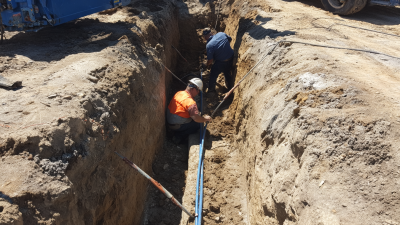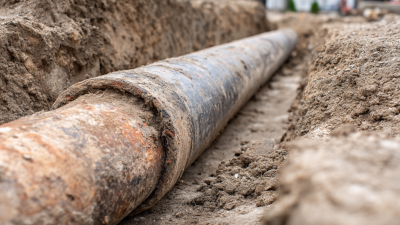How to Effectively Address Sewer Issues with No-Dig Solutions
In the realm of urban infrastructure, sewer issues can pose significant challenges for both homeowners and municipal authorities. Traditional methods of sewer repair often involve extensive digging, leading to disruptions in daily activities, increased costs, and potential damage to surrounding landscapes. However, the emergence of innovative no-dig solutions has revolutionized the way we approach sewer maintenance and repair. These modern techniques offer efficient and effective means of addressing sewer problems while minimizing disturbance. This article will explore the various no-dig methods available for sewer repair without digging, highlighting their advantages, technology, and real-world applications. By understanding these solutions, property owners and city planners can mitigate issues effectively while preserving the integrity of their environments.

Understanding No-Dig Technology: An Introduction to Trenchless Solutions
No-dig technology, often referred to as trenchless solutions, has revolutionized the way we address sewer issues. According to a report by the International Society for Trenchless Technology, the use of trenchless methods can reduce excavation time by up to 70%, significantly lowering labor costs and minimizing the disruption to surrounding areas. This innovative approach allows for the installation, repair, or rehabilitation of sewer lines without the need for extensive digging, which is especially beneficial in densely populated urban environments where traditional methods could disrupt traffic and daily life.

One of the most prominent techniques in no-dig technology is cured-in-place pipe (CIPP) lining, which has seen a growth rate of approximately 15% annually in recent years. This method involves inserting a resin-saturated liner into the existing pipe, which is then cured to create a new, durable pipe within the old one. According to a report from Market Research Future, the trenchless technology market is expected to surpass $8 billion by 2025, reflecting its increasing adoption and the consistent need for efficient, cost-effective sewer maintenance solutions in an era where infrastructure demands are ever-growing.
Identifying Common Sewer Issues That Can Benefit from No-Dig Methods
Identifying common sewer issues is essential for homeowners and property managers looking to maintain effective drainage systems without the disruption of traditional digging methods. According to a report from the American Society of Civil Engineers (ASCE), approximately 22% of sewer infrastructure in the United States is classified as being in poor condition. This deterioration often leads to blockages, tree root invasions, and cracks that can result in significant property damage if not promptly addressed.
No-dig solutions, such as trenchless technology and pipe relining, are increasingly recognized as beneficial strategies for dealing with these issues. For example, a study by the National Association of Sewer Service Companies (NASSCO) highlights that trenchless methods can reduce project completion time by 50% compared to traditional techniques, while also minimizing the environmental impact and preservation of existing structures. Common problems like inflow and infiltration, which can waste up to 3.5 billion gallons of treated water daily, can effectively be tackled with these innovative approaches, ensuring that sewer systems operate efficiently without the need for extensive excavation.
How to Effectively Address Sewer Issues with No-Dig Solutions - Identifying Common Sewer Issues That Can Benefit from No-Dig Methods
| Sewer Issue | Description | No-Dig Solution | Advantages |
|---|---|---|---|
| Tree Root Intrusion | Roots from nearby trees penetrate sewer lines, causing blockages. | Trenchless Technology | Minimized disruption, cost-effective, quick repair. |
| Pipe Corrosion | Old pipes deteriorate due to rust and wear, leading to leaks. | CIPP (Cured In Place Pipe) Lining | Extends pipe life, prevents leaks, reduces future maintenance. |
| Offset Joints | Sewer joints become misaligned, causing backups and leaks. | Pipe Bursting | Simultaneously replaces old pipe, minimal digging required. |
| Bellied Pipes | Sections of pipe sag, leading to standing water and clogs. | Epoxy Coating | Helps restore function, prevents further damage. |
| Grease Blockages | Accumulation of grease and food particles blocks sewer flow. | Hydro Jetting | Thorough cleaning, eco-friendly, and physically removes buildup. |
Exploring the Various No-Dig Techniques for Sewer Repair and Maintenance
No-dig solutions have revolutionized the way sewer issues are addressed, providing efficient and minimally invasive options for repair and maintenance. One of the most common techniques is trenchless technology, which allows for repairs to be made without the need for extensive excavation. This method typically involves the use of pipe bursting or horizontal directional drilling, each offering distinct advantages. Pipe bursting replaces damaged pipes by breaking them apart while simultaneously pulling new piping into place, significantly reducing surface disruption.
Another effective no-dig technique is the use of cured-in-place pipe (CIPP) lining. CIPP involves inserting a resin-saturated liner into the existing sewer pipe, which is then cured to form a rigid, seamless new pipe within the existing one. This method effectively seals leaks, restores structural integrity, and extends the lifespan of the sewer system. Additionally, no-dig solutions minimize the impact on the surrounding environment and infrastructure, making them a preferred choice for urban settings where traditional excavation could cause significant disruption. By exploring these various methods, property owners can find effective ways to tackle sewer issues without the drawbacks of conventional repair techniques.
Effectiveness of Various No-Dig Solutions for Sewer Repair
Evaluating the Advantages of No-Dig Solutions Over Traditional Excavation
No-dig solutions for sewer issues have gained significant traction, particularly due to their numerous advantages over traditional excavation methods. With the North American trenchless pipe rehabilitation market projected to grow from $1.97 billion in 2025 to $3.05 billion by 2032, it is evident that more property owners are recognizing the benefits of these innovative techniques. No-dig methods minimize surface disruption, reduce project timelines, and lower overall costs, making them an attractive option for municipalities and homeowners alike.
Tips for effectively addressing sewer issues using no-dig solutions include conducting a thorough inspection of the sewer system to identify the extent of damage or blockages before proceeding with repairs. It’s also essential to select the right no-dig technology, such as pipe bursting or cured-in-place pipe (CIPP), depending on the specific circumstances of your sewer problems. Additionally, ensure that you hire experienced contractors familiar with no-dig processes to guarantee high-quality repairs.
When considering no-dig solutions, be aware of the long-term benefits they offer, such as minimized environmental impact and reduced risk of future disruptions to the property. By embracing these methods, property owners can efficiently maintain their sewer systems, ensuring ongoing functionality and reducing the need for frequent repairs.

Implementing No-Dig Solutions: Best Practices for Successful Sewer Repair Projects
When addressing sewer issues, implementing no-dig solutions is becoming increasingly popular due to their efficiency and minimal disruption. The first best practice for successful sewer repair projects is thorough assessment and planning. Utilizing advanced technologies such as CCTV inspection allows for a precise diagnosis of the problem. This ensures that the no-dig method chosen—whether it be trenchless pipe lining or pipe bursting—aligns with the specific needs of the project. An accurate assessment can significantly enhance the effectiveness of the repair while reducing unforeseen complications.
Another crucial aspect is the selection of high-quality materials and technologies. Utilizing durable and reliable products, such as cured-in-place pipes or high-density polyethylene, not only improves the longevity of the repair but also ensures compliance with industry standards. Additionally, having a skilled team that is well-versed in no-dig techniques can optimize the process. Continuous training and staying updated with the latest advancements in trenchless technology contribute to smoother executions of repair projects, ultimately leading to better outcomes and customer satisfaction.
Related Posts
-

Innovative Approaches to Sewer Repair Without Digging A Comparative Analysis of Efficiency and Cost
-

How to Use Trenchless Technology for Effective Sewer Repair Solutions
-

Creative Options for Sewer Repair Without Digging Methods You Should Consider
-

Unlocking the Advantages of No Dig Sewer Repair for Modern Infrastructure
-

7 Best Reasons to Choose CIPP Sewer Repair for Your Next Infrastructure Project
-

How to Effectively Address Sewer Line Issues without the Need for Excavation

